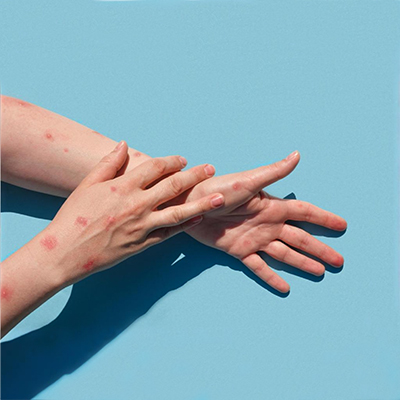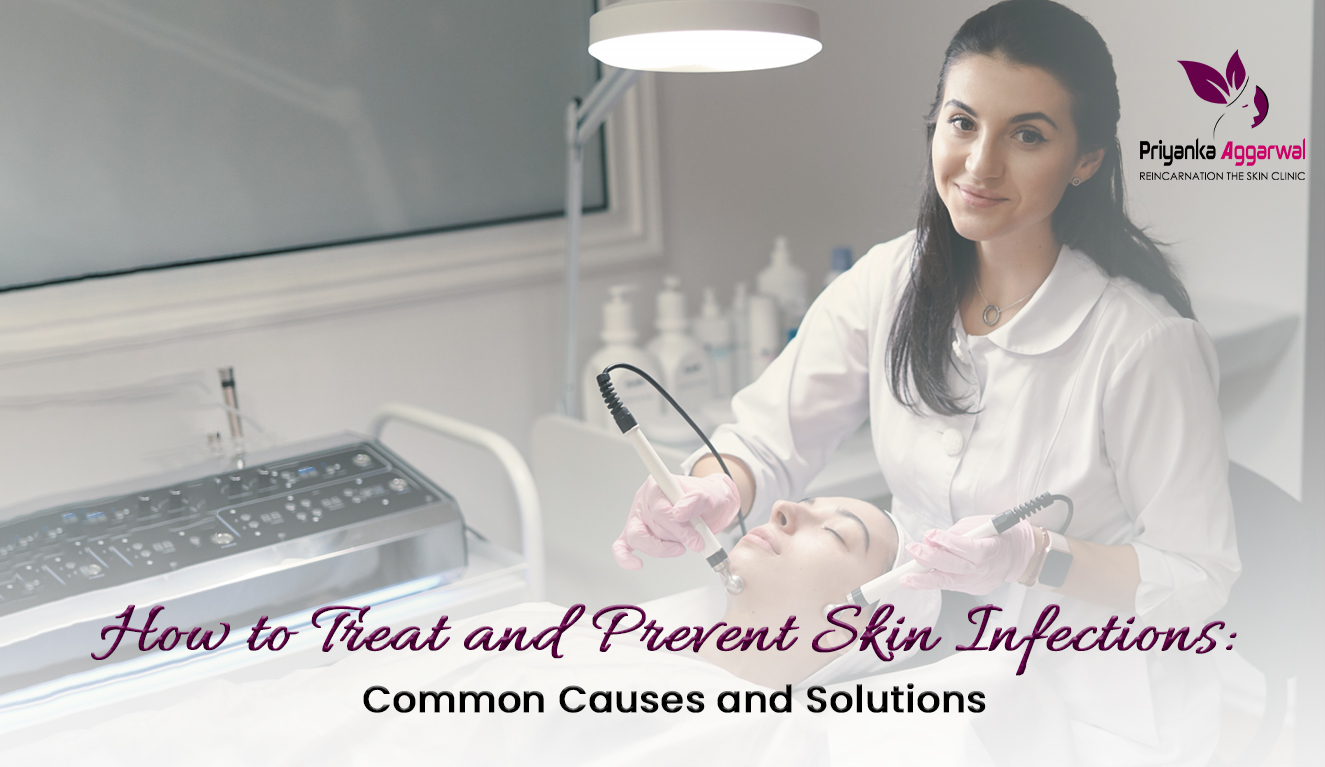Skin infections rank among those key concerns for many and may result from various reasons. If left without proper treatment, poor comfort, irritation, and sometimes serious complications could cause bacterial, fungal, or viral infections. Thus, in this blog, we shall discuss what skin infections are, what the common causes are, how to identify them, treatment options, and ways of prevention. We also emphasize when we should see a dermatologist for professional treatments at the right time.
What Are Skin Infections?
This is a form of skin infection, a penetrating invasion of disease-causing germs that could be fungi and viruses. These germs often cause irritation and other effects on the skin, such as rashes, boils, blisters, or pus-ridden sores. Many of them are minor and self-limiting, though others can be piercingly painful, uncomfortable, or permanently damaging.
Of course, it is very important to mention that skin infections have no age or health barrier. The seriousness of the infection, therefore, has to be determined by factors such as the type of infection, the area affected in the skin, and the individual’s overall immunity.
Common Causes of Skin Infections
You would know the most common causes of skin infections and then take the necessary precautions when you catch an infection and seek proper treatment. Some of the most common causes of skin infections are given below.
Bacterial infections
Among the most common causes of skin infections are bacteria. Some of the more common bacterial skin infections include:
- Impetigo: It is a highly contagious bacterial infection caused by bacteria such as Staphylococcus aureus or Streptococcus pyogenes. It characteristically begins as red sores appearing around the mouth and nose.
- Cellulitis: The infection deepens in the skin and tends to augment redness, swelling, and pain.
- Folliculitis: Resulting from hair follicles becoming infected and manifesting as pimples or pustules.
Fungal Infections
Fungal infections often thrive in warm, moist environments. Common areas for fungal infections include the feet, groin, or armpits. Some common fungal infections include:
- Ringworm: It is usually a red, circular rash spread over parts of the body such as the scalp, feet, and body.
- Athlete’s Foot: This is a fungal infection of the feet characterized by itching, redness, and peeling.
- Candidiasis: This infection is due to the yeast Candida. It is mainly associated with disease of the mouth, skin folds, and genitals.
Viral Infections
Viruses particularly often cause skin infections. In particular, the following are the most common viral infections:
- Herpes Simplex Virus (HSV): This virus causes cold sores or genital sores. It is very contagious. It is caused by the varicella-zoster virus and is due to itchy blisters with chickenpox and acute localized pain shingles. Human Papillomavirus (HPV): This virus causes warts and can grow on the skin, which, in some cases, appears on the hands, feet, or genital areas.
- Insect Bites and Stings: Insect bites or stings cause localized infection. When scratched, these areas will introduce bacteria that bring swelling, redness, and pus. 5. Bad hygiene and an unclean environment For example, poor hygiene may either be a result of less frequent washing or wounds that are not properly cleaned. Moreover, dirt contamination in different public settings can cause infections.
How to Identify a Skin Infection
Early discovery of the infection can help one with its proper treatment. Here are some common signs and symptoms of skin infections:

- Redness and inflammation: This is a red, swollen, or warm area of the skin; one of the first signals of infection.
- Pain or Tenderness: Infected skin, which often becomes tender to the touch, may exhibit pain in the inflammation.
- Pus or Drainage: The infection is characterized often by the presence of pus or fluid-filled blisters, often in bacterial infections.
- Itching or Burning: The skin feels very itchy or burning in certain infections.
- Fever: In severe cases, fever may be an indication that this body is trying to overcome the infection. It is mostly advisable to take urgent measures if any of these symptoms are noticed since early treatment prevents the worsening of the infection.
Treat Common Skin Infections
The treatment of skin infection depends on the kind and gravity of the infection. The following are a few common types of treatment for various skin infections:
Bacterial infections
In most cases, bacterial infections are treated with antibiotics. Topical antibiotics such as neomycin or bacitracin can be administered to help improve localized infections, or oral antibiotics may be prescribed to treat more serious cases such as cellulitis or impetigo.
Fungal Infections
Most fungal infections are treated via lotions, antifungal powders, or oral medications. Mild ringworm infection, known as athlete’s foot, is best managed with over-the-counter clotrimazole or miconazole fungi creams. More severe fungal infections require prescription of either oral antifungal medication, such as terbinafine or fluconazole.
Viral Infections
Viral diseases, such as herpes simplex or shingles, will respond to antiviral therapy. Local antivirals, like acyclovir, will soften and shorten the duration of attacks. For conditions such as warts, treatments might include cryotherapy, for example, freezing the wart or salicylic acid applied topically to the wart.
Home Remedies for Minor Skin Infections:
Warm Compress: Use a warm, damp cloth on the affected area, and that reduces the pain and inflammation. Aloe vera: it has a soothing effect, calming down the irritated state of skin easily and quickening healing. Tea Tree Oil This oil is highly antimicrobial yet can be used to treat minor patches of skin infection. It does, however, need to be diluted with a carrier oil. It should be mentioned that the following remedies are valid only for minor infections. More serious infections are better treated by a professional physician.
Prevent Skin Infections
Prevention is always better than cure, and there are many precautions you can take so that your skin won’t easily be affected by infections.

- Keep proper hygiene: Soap and water cleaning frequently wash away dirt, oil, and bacteria that may have entered the skin. Cleaning up wounds, cuts, or scrapes early prevents infections from developing.
- Use your personal items: Avoid sharing towels, razors, or other personal items—they harbour a good number of bacteria or fungi that cause infections.
- Wears Clean, Breathing Clothing: This requires airy clothes and a change from drenched clothing after a workout to avoid fungal infections like athlete’s foot.
- Apply antiseptic on wounds and grazes: Clean any small cut or abrasion with antiseptic and dress with a bandage so that you will not allow germs to penetrate inside the wound.
- Keep skin dry: This is because fungi thrive in moist environments, so your skin, especially in the feet, groin, and armpits, should be kept as dry as possible. 6. No scratching Never scratch the infected skin because it might exacerbate the infection and spread to other parts of your body. Have that urge resisted, and clean the area instead.
When to Visit a Dermatologist
The other infections affecting the skin may be managed through over-the-counter remedies or home care, but there are times when you should see a dermatologist. Such instances are,
- If it fails to respond to the treatment within a few days.
- If the infection spreads to other parts of the body.
- If pain, swelling, or fever is severe.
- If it falls in your eyes, face, or privates.
If there are predisposing factors to an underlying condition, including diabetes or impaired immunity, which may worsen the condition of infections. Dr. Priyanka Aggarwal is one of the most renowned dermatologists, who provides treatment for all types of skin infections and other dermatological diseases. She treats patients using knowledge and practices with years of experience with different types of problems in the skin.
Conclusion:
Skin infections can be treated with proper prevention and treatment, but if the reasons for infection are not known, then early signs of infection and good hygiene practices would help protect the skin from various infections and their occurrences. Approach a dermatologist like Dr. Priyanka Aggarwal when you feel that there are some symptoms persisting over time or the infection is severe. The patient shall be treated and cared for to prevent complications and to have healthy, infection-free skin.
Read more: How to Know When Your Skin Needs a Dermatologist Appointment
FAQ
What is the best treatment for skin infections?
Treatment depends mainly on the type and severity of the infection.
Bacterial Infections: Measurably are treated with antibiotics, either topically if the disease is minor or orally for severe diseases.
Fungal infection: topical solutions like clotrimazole or miconazole might be effective for mild infections. In worse infections, the patient might be prescribed oral antifungal medications.
Viral infections: Antiviral medications, like acyclovir, shorten and lessen the severity of viral infections such as herpes. A dermatologist should be consulted if the infection has not cleared up on its own or is severe.
Can skin infections heal on their own?
Even minor skin infections will become self-limiting, especially minor bacterial or fungal infections, with some of them healing spontaneously. Good hygiene, keeping the area clean, along with a conscious effort not to scratch, is highly helpful in the healing of the infection. Professional treatment will be most likely when the symptoms worsen or the infection spreads.
What is the best home remedy for skin infections?
For minor infections, consider the following home remedies for relief:
Warm Compress: Apply over the affected area to help alleviate discomfort or pain and swelling. It can even draw pus if there are small abscesses.
Aloe Vera: It is applied directly to calm and heal the affected skin to reduce inflammation and promote healing.
Tea Tree Oil: It is a diluted, antimicrobial tea tree oil and can be applied at low levels to help with minor skin infections. Properly administer with carrier oil, like coconut oil, to avoid irritation.





